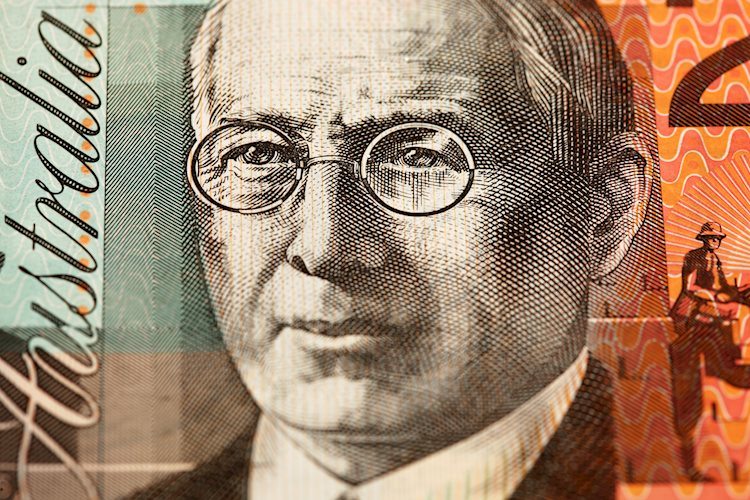
- AUD/USD loses ground near 0.6810 in Monday’s early Asian session.
- The expectation of further Fed rate cuts this year might weigh on the USD in the near term.
- The RBA is expected to keep the OCR unchanged at its September meeting on Tuesday.
The AUD/USD pair trades with a mild negative bias around 0.6805 during the early Asian session on Monday. The softer Australian Dollar (AUD) creates a headwind for the pair. Investors will keep an eye on the flash reading of the US Purchasing Managers Index (PMI) on Monday for fresh impetus.
The US Federal Reserve (Fed) cut interest rates by a larger-than-usual half-percentage point to a range of 4.75 to 5.00% last week. Policymakers also predicted an additional 75 basis points (bps) of rate cuts by the end of the year, which could continue to undermine the US Dollar (USD) against the AUD. Fed Chair Jerome Powell noted that the move was meant to show policymakers’ commitment to keeping unemployment low as inflation eases.
Fed Philadelphia President Patrick Harker said on Friday that the US central bank has effectively navigated a challenging economy over the last few years. He added that “hard” and “soft” data are both important in decision-making.
On the Aussie front, data released by Judo Bank and S&P Global on Monday showed that the preliminary reading of Australia’s Judo Bank Manufacturing PMI dropped to 46.7 in September from 48.5 in August. Meanwhile, the Services PMI eased to 50.6 in September versus 52.5 prior, and the Composite PMI fell to 49.8 in September from 51.7 in the previous reading. The AUD trades with mild losses in an immediate reaction to the decline in Australian PMI readings.
The Reserve Bank of Australia (RBA) will announce its interest rate decision on Tuesday, which is anticipated to keep the Official Cash Rate (OCR) at 4.35%. RBA governor Michele Bullock said that policymakers do not expect an interest rate cut in the “near term” and the RBA wouldn’t be swayed by other nations cutting rates.
The Australian economy added more jobs than expected in August as the unemployment rate remained steady, making the case for interest rate cuts less likely in the short term. The Unemployment Rate in August came in at 4.2%, the Australian Bureau of Statistics reported last week. The consensus had expected it to remain in line with the 4.2% in July. The RBA rate decision will take center stage on Tuesday, followed by a press conference with Bullock.
Australian Dollar FAQs
One of the most significant factors for the Australian Dollar (AUD) is the level of interest rates set by the Reserve Bank of Australia (RBA). Because Australia is a resource-rich country another key driver is the price of its biggest export, Iron Ore. The health of the Chinese economy, its largest trading partner, is a factor, as well as inflation in Australia, its growth rate and Trade Balance. Market sentiment – whether investors are taking on more risky assets (risk-on) or seeking safe-havens (risk-off) – is also a factor, with risk-on positive for AUD.
The Reserve Bank of Australia (RBA) influences the Australian Dollar (AUD) by setting the level of interest rates that Australian banks can lend to each other. This influences the level of interest rates in the economy as a whole. The main goal of the RBA is to maintain a stable inflation rate of 2-3% by adjusting interest rates up or down. Relatively high interest rates compared to other major central banks support the AUD, and the opposite for relatively low. The RBA can also use quantitative easing and tightening to influence credit conditions, with the former AUD-negative and the latter AUD-positive.
China is Australia’s largest trading partner so the health of the Chinese economy is a major influence on the value of the Australian Dollar (AUD). When the Chinese economy is doing well it purchases more raw materials, goods and services from Australia, lifting demand for the AUD, and pushing up its value. The opposite is the case when the Chinese economy is not growing as fast as expected. Positive or negative surprises in Chinese growth data, therefore, often have a direct impact on the Australian Dollar and its pairs.
Iron Ore is Australia’s largest export, accounting for $118 billion a year according to data from 2021, with China as its primary destination. The price of Iron Ore, therefore, can be a driver of the Australian Dollar. Generally, if the price of Iron Ore rises, AUD also goes up, as aggregate demand for the currency increases. The opposite is the case if the price of Iron Ore falls. Higher Iron Ore prices also tend to result in a greater likelihood of a positive Trade Balance for Australia, which is also positive of the AUD.
The Trade Balance, which is the difference between what a country earns from its exports versus what it pays for its imports, is another factor that can influence the value of the Australian Dollar. If Australia produces highly sought after exports, then its currency will gain in value purely from the surplus demand created from foreign buyers seeking to purchase its exports versus what it spends to purchase imports. Therefore, a positive net Trade Balance strengthens the AUD, with the opposite effect if the Trade Balance is negative.

